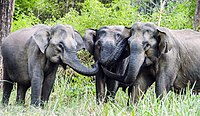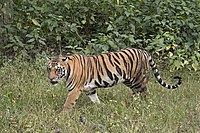List of protected areas of West Bengal
Protected areas of West Bengal cover 4% of the state area.Sundarbans, is located in southern West Bengal.[4]
There are 6
wildlife sanctuaries in West Bengal.[5]
National Parks and Wildlife Sanctuaries
- Ballabhpur Wildlife Sanctuary
- Bethuadahari Wildlife Sanctuary
- Bibhutibhushan Wildlife Sanctuary
- Buxa Tiger Reserve
- Chapramari Wildlife Sanctuary
- Chilapata Forest
- Chintamoni Kar Bird Sanctuary
- Gorumara National Park
- Haliday Island Wildlife Sanctuary
- Jaldapara National Park
- Jore Pokhri Wildlife Sanctuary
- Lothian Island Wildlife Sanctuary
- Mahananda Wildlife Sanctuary
- Neora Valley National Park
- Narendrapur Wildlife Sanctuary
- Pakhi Bitan Wildlife Sanctuary
- Raiganj Wildlife Sanctuary
- Ramnabagan Wildlife Sanctuary
- Rasikbil Bird Sanctuary
- Sajnekhali Wildlife Sanctuary
- Senchal Wildlife Sanctuary
- Singalila National Park
- Sundarbans National Park
- Mayurjharna Elephant Reserve
Fauna
A number of endangered animals live in the forests of the
. Some birds areTarai grey langur, Northern plains gray langur, and binturong are some arboreal creatures, and swine include pygmy hog and Indian boar. Bengal fox, Indian jackal, Indian wolf, and spotted linsang are some of the predators besides tigers. The hispid hare is a very rare species which is found here. Leopard cat and Asian golden cat have been recorded. Up north, Himalayan tahr, Bhutan takin, Himalayan goral, and Himalayan serow
are found.
In rivers,
mountain hawk eagle, Pallas's fish eagle, and shikra
have been discovered.
The Buxa Tiger Reserve is famous for butterflies, like
five-bar swordtail, while Jore Pokhri Wildlife Sanctuary is the last refuge for Himalayan salamander (or newt). Pokhari Lake supports species of catfish. There have been recent sightings of the Ussuri dhole in Jaldapara National Park of Dooars as well. Sightings of black panther in the forests of Dooars are not uncommon. Jaldapara National Park has the largest Indian rhinoceros population in the world after Kaziranga National Park. The East Kolkata Wetlands in Kolkata is home to the small Indian mongoose, Asian palm civet, small Indian civet, lesser whistling duck, purple heron, grey heron, great egret, little egret
, and many more waterfowl and waders.
The Sajnekhali Wildlife Sanctuary is home to
rice paddy eel, butter fish, largetooth sawfish, and electric ray along the Bay of Bengal.[6] Crabs include fiddler crab, king crab, and hermit crab
.
In the rural areas like
domestic water buffalo are seen in streets, along with Indian pariah dogs
.
Blackbucks are found near Midnapore as well.
Beautiful and exotic birds inhabit
common emigrant, and tarucus
.
The oxbow lake of
common coot, and osprey
.
The lake in
.Flora[7]
From a phytogeographic viewpoint, the southern part of West Bengal can be divided into two regions: the
water hyacinth
is very common in lakes and ponds. Species of elephant grass create large grasslands near Dooars.
References
- ^ "West Bengal: General Information". India in Business. Federation of Indian Chambers of Commerce and Industry. Archived from the original on 2006-08-19. Retrieved 2006-08-25.
- ^ "Flora and Fauna". calcuttayellowpages.com (P) Ltd. Archived from the original on 2006-08-26. Retrieved 2006-08-25.
- ISBN 81-7955-030-3. Archived from the original(PDF) on 2006-05-27. Retrieved 2006-08-26.
- ^ Islam, Sadiq (June 29, 2001). "World's largest mangrove forest under threat". CNN Student Bureau. Cable News Network. Archived from the original on 2007-08-22. Retrieved 2006-10-31.
- ^ "West Bengal". Directory of Wildlife Protected Areas in India. Wildlife Institute of India. Archived from the original on 2007-02-02. Retrieved 2006-10-26.
- ^ ISBN 81-7955-030-3. Archived from the original(PDF) on 2006-05-27. Retrieved 2006-08-26.
- ^ Akash Banerjee
- ^ a b c Mukherji, S.J. (2000). College Botany Vol. III: (chapter on Phytogeography). Calcutta: New Central Book Agency. pp. 345–365.
- ^ Snedaker, Samuel. "Notes on the Sundarbans with Emphasis on Geology, Hydrology, and Forestry". A.K. Townsend. Archived from the original on 2006-06-30. Retrieved 2006-11-01.
- ^ a b "Natural vegetation". West Bengal. Suni System (P) Ltd. Archived from the original on 2006-05-23. Retrieved 2006-10-31.
External links
Wikimedia Commons has media related to Protected areas in West Bengal.





